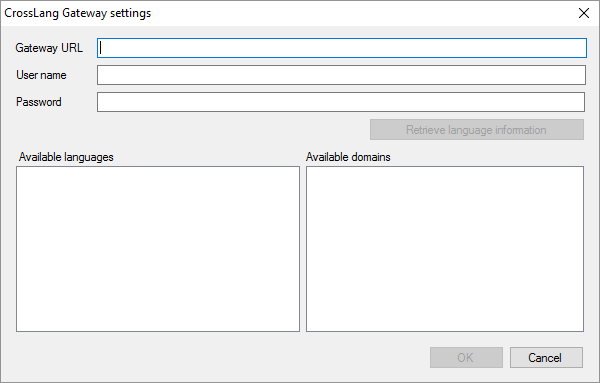Crosslang Gateway settings
Set up CrossLang Gateway to work with memoQ. The CrossLang Gateway is a middleware solution that enables the user to connect to a wide range of machine translation technologies, including commercial as well as open-source rule-based, statistical, and neural machine translation systems. The version 1.0.2 (in memoQ 9.0 and newer) handles basic formatting (for example, bold or italic text) if there are no tags in the segment.
How to get here
-
At the top of the memoQ window, click the Resource console
 icon. The Resource console window opens.
icon. The Resource console window opens. -
In the Server URL list, choose or type the server's address.
To see local resources only, choose My computer, and click the Select
 button.
button. -
In the left-side pane, click the MT settings
 icon. The MT settings pane opens.
icon. The MT settings pane opens.If you have projects with more than one target language, in the top-right corner, choose a language from the Target language dropdown list.
If you want to use the same MT settings for all target languages, don't change the default value (All languages).
-
Select the MT settings resource and click Edit under the list.
-
On the Services tab, find the plugin and click its row.
-
If it's active, click its row to open the Crosslang Gateway settings window.
-
If it's grayed out, click its row once to turn it on, then click it again to open the settings.
-

What can you do?
- Obtain your access: Contact CrossLang.
- Enter the details of your access: the Gateway URL, your user name and password. for the CrossLang Gateway.
- Click Retrieve language information. memoQ will show what languages and subject fields are available with the tool.
When you finish
To save the settings and return to the Default resources tab of the Options window (or to the Resource console): Click OK, then click OK again.
To return to the Default resources tab of the Options window (or to the Resource console), without saving the new settings: Click Cancel, then click Cancel again.
To use the MT output in the translation editor:
- Open a project with a supported language pair.
- On the left side of the Project home or memoQ online project screen, click Settings.
- In the top bar, click the MT settings
 icon.
icon. - Choose the MT profile in the project, or one you want to add to the project. Below the list, click Edit.
- On the Services tab of the Edit machine translation settings window, check the plugin's checkbox on the left.
- On the Settings tab of the Edit machine translation settings window, in the Translation results area, choose a setting other than Off.
- Open a document for editing, and see the machine-translated suggestions.
To use the MT output in pre-translation:
- Open a project with a supported language pair.
- On the left side of the Project home or memoQ online project screen, click Settings.
- In the top bar, click the MT settings
 icon.
icon. - Choose the MT settings resource in the project, or one you want to add to the project. Below the list, click Edit.
- On the Services tab of the Edit machine translation settings window, check the plugin's checkbox on the left.
- On the Settings tab of the Edit machine translation settings window, select the plugin from the Pre-translation dropdown.
- Run Pre-translate. In the Pre-translate and statistics window, select the Use machine translation if there is no TM match checkbox. (memoQ will remember this.)